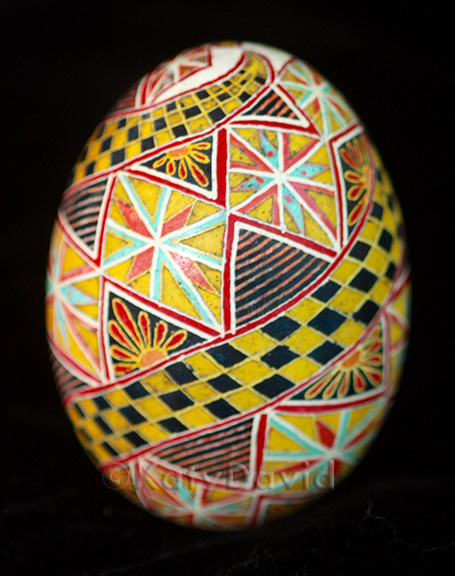A highly stylized clematis vine, climbing and twisting and reaching upward to the sky.
I wrote out the process and divided it into steps so you could understand more clearly the process of layering that I go through to produce one of these pieces.
Step 1: I penciled in the equator, then the longitude and latitude lines and the halves of those lines, ending up with a grid. Then Ipenciled in a line where these lines connected that spirals up the egg. Once I have the basic geometry drawn in, then I can see where I am going and how to get there.
Step 2: I started waxing on a brown chicken egg, as you can see from the outlines of the vine and flowers.
Step 3: After waxing, I etched the egg in vinegar to remove the brown outer layer and expose the lighter inner layer.
Step 4: I then dipped the egg in UGS Light Blue and waxed the outer blue line of the leaf.
Step 5: Next I dipped the egg in PUSA Patina and waxed the second slightly more green line on the inner portion of the leaf.
Step 6: I dipped again in PUSA Patina for a longer time than I normally would in order to get the dark green inner color of the leaves.
Step 7: In order to ensure a bright and clear color, I washed the dye off with soap and water.
Step 8: I etched the surface again in vinegar to make the egg ready for more dyeing.
Step 9: Now it was time for UGS Purple. I waxed the outer line of the petal.
Step 10: Then I rinsed the egg under running water to get just some of the dye off the eggshell, leaving enough so I could achieve a lighter purple color and waxed that inner line of the flower petal.
Step 10: Finally, I washed the egg back down to the light creamy shell color and allowed the egg to rest for a few days. I like to give the egg time to dry out from all the processing it has been through. The heat of the oven can turn the moisture of all the dyeing and waxing that is in the eggshell to steam and cause seepage from the pores that shows as random white blobs. Sometimes I like that effect but sometimes I want to have a bit more control over the final design. If you look closely in the lightest part of the purple petals you can see dots of the blue-green color. Similar to what happens in the oven, the warmth of my hand as I hold and work on the egg heats the air inside the eggshell which forces the dye back out through the pores. I like that this eggshell added it's own signature to the piece.
Happy Friday!
































